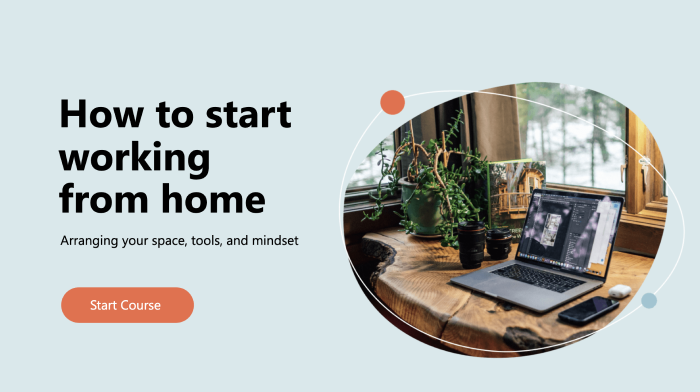Learning Goals and Objectives in Course Design – The Whats, Whys, and Hows

Have you ever sat through a training program or workshop and wondered, “What’s the point of this? Why am I here?” If so, then it was likely lacking well-defined instructional goals and objectives. But these questions crop up more frequently with online training, where learning is self-directed with minimal guidance.
These are the last questions any instructional designer or L&D professional wants trainees to ask. Your ultimate aim is to inspire intrinsic motivation by generating relevant, engaging, and learner-centric content. Learners best assimilate, retain, and apply knowledge when these principles are respected throughout your training.
As such, the importance of setting crystal clear expectations – for yourself and your students – cannot be understated. In this article, we’re going to explore the whats, whys, and hows of creating effective learning goals and objectives.
What Is a Learning Goal?
Let’s first start with the “whats” of learning goals. A learning goal is defined as an overarching statement of what you intend to teach. Note the slight distinction between what you intend to teach versus have the trainee learn.
Remember, as an ID or L&D professional, you’re not on the learner-side of training; you’re acting as the instructor. Therefore, your course goals should be focused on what you aim to accomplish with your program.
Put otherwise, learning goals give you an aerial perspective of your entire course roadmap. Though you’re far from the development stage, they provide you with the direction and focus needed to design a cohesive training program. Only then will you be able to research and generate relevant content that prioritizes your audience’s needs.
How many learning goals do you need?
Because instructional goals give rise to learning objectives, less is more. The fewer the goals, the easier it will be to create specific, focused objectives. Ideally, you should aim for one solid goal. But this won’t always be possible, depending on how inherently comprehensive the topic is.
Either way, minimizing the number of course goals provides intentionality – the ability to understand the purpose and importance of your course. So, if ever faced with the dreaded question, “What’s the point of this?”, you’ll be able to counter it with your learning goal statement(s).
Types of Learning Goals
At the end of the day, your company-specific needs drive your learning goals. So there are infinite possibilities. That notwithstanding, educational goals can be divided into 4 broad categories.
Short-term vs. long-term goals
Short-term goals provide instant gratification, allowing learners to experience the fruits of their labor. You can think of these goals as milestones; they’re realistic, attainable, and yield tangible results. They further pave the way for long-term goals. For example, if you’re training newly hired sales professionals on using a CRM, a short-term goal could specify “be able to create a deal in CRM”.
Long-term goals are more complex. On the road to these goals, learners must successfully progress through a series of short-term goals or “steps.” In keeping with our CRM example, a long-term goal might be to “be able to manage your leads and customers in a pipeline effectively.”
Knowledge/Skills-related and behavioral goals
Knowledge/Skills-related goals are more specific than long-term goals. They outline which specific topics or skills within your training program are most important to focus on. Therefore, within a company, they’re often tailored towards specific trainee roles or positions.
If you’re a web development company, the knowledge and skills required of a marketing strategist differ greatly from those of a UX designer. If you’d like them to enhance their performance respectively, then creating knowledge- or skills-based goals will clarify whether to divide your course accordingly, or create entirely separate programs.
Behavioral goals aim to promote a more pleasant and productive work or classroom environment by inspiring better work and/or study habits, as well as positive attitudes and interactions.
Perhaps you work for a company that’s rapidly expanding or evolving. And the constant changes and adjustments are causing chaos and undue stress. Then, a behavioral goal could be to “develop effective coping strategies to adapt and thrive in dynamic or stressful work environments.”
What Is a Learning Objective?
A learning objective is student-centered and thus fixates on what they (versus you) will get out of the course. Though highly specific in nature, it is broadly defined as a statement that precisely outlines the desired outcomes or terminal behavior that learners should achieve by the end of the course.
Remember, learning goals are broad in nature and are supposed to birth learning outcomes.
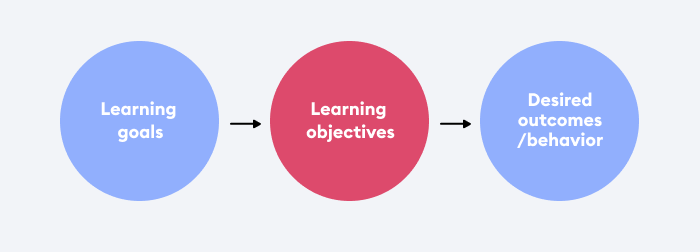
Accordingly, you can conceptualize a mind map, wherein learning goals are parent nodes and the objectives are child nodes.
Put otherwise, learning objectives are subsets of educational goals that focus on student learning outcomes and behaviors. As a result, they’re inherently specific and focused in nature.
Learning objectives – the more the merrier?
Your training can encompass as many learning outcomes as needed, depending on its length and depth of complexity. But in practice, one learning goal usually yields 3-5 learning objectives. That said, don’t go overboard!
While goals are inherently broad, sometimes they can be broken down further to yield respective sets of objectives for each. Again, to keep things relevant and focused, you might need to reorganize, separate, or split your course accordingly. This process demonstrates how learning objectives inherently drive course design.
What Is the Difference Between a Learning Goal and an Objective?
Although we’ve touched on this topic lightly, this section provides a comprehensive table that summarizes – at a glance – the difference between goals and objectives in education.
| Comparison points | Learning goals | Learning objectives |
| What do they address? | “What’s the purpose of this course?” | “What’s in it for me if I take this course?” |
| Who do they address? | Training professionals (ID, L&D, teachers, etc.) | Learners (trainees, students, customers) |
| Degree of specificity | Broad. They provide descriptions of general long-term goals. | Highly specific. They describe the desired learning outcomes/behavior. |
| Are they measurable? | No. They are too broad and abstract in nature to be quantified. | Absolutely. Their specificity is used to create effective and measurable assessments. |
| What do they give rise to? | Learning objectives | Assessments, assignments, and tools that help objectively evaluate learner progress |
| How many are ideal? | Less is more for focus and relevance. 1 to 3 is common. | It depends on your number of learning goals. 3-5 is average per goal. |
Examples of learning goals and objectives
Now that we’ve highlighted all the main differences in a snapshot, we’ve drafted a table that provides tangible learning goals and examples of the objectives they might yield.
Training program | Learning goals | Learning objectives |
| Leadership Development | This course aims to unlock the leadership potential of managers to enhance team performance and productivity. | Learners will be able to:
|
| Hazardous Materials (WHIMIS) | This training aims to familiarize employees with WHIMIS to foster a safe work environment. | Employees will be able to:
|
| First Aid/CPR | Learners will know how to properly administer first aid/CPR to prevent or mitigate first aid emergencies. | Learners will be able to:
|
| Sales Strategies | Trainees will learn new sales strategies to increase the company’s revenue. | Learners will be able to:
|
| Company Culture | New onboards will align with the company’s vision, mission, and values. | Trainees will be able to:
|
Pay close attention to these examples of learning goals and objectives. What do you notice about the types of verbs used in the “goals” versus “objectives” column? Evidently, learning goals are broad and thus lend themselves to abstract verbs that are unactionable.
In contrast, it’s easier to quantify or measure learning outcomes, wherein the verbs are more agentive (they require learners to “actively perform” them).
Now that we’ve delineated the whats, whys, and differences between learning goals and objectives, let’s put everything together with the “hows”!
Also read: How to Build a Learning Culture
Why Is It Important to Set Learning Objectives?
When enrolling in a training program, or anything for that matter, the first thing a prospective audience wants to know is, “What’s in it for me?” This singular question gets at the crux of why setting learning objectives is essential. In essence, they inspire intrinsic motivation in your learners when they reframe these outcomes as “tangible rewards.”
Not only do “rewards” intrigue prospective learners, but they make the course engaging, relevant, and valuable for them. Therefore, much of their motivation comes from within rather than from external pressure. This is particularly crucial with eLearning, where no one’s there to crack the whip or hold learners accountable.
Well-defined learning outcomes are also essential to eLearning because they…
- Inform your selection of valuable and relevant content
- Make the overall course design process more efficient
- Direct trainees to the most important/relevant content
- Naturally align with the effectual method of SMART goal setting
- Enhance the quality of your assignments and evaluations
- Provide opportunities for reflection, memory recall, and higher-order thinking
- Serve as key points of reference when diagnosing poor engagement, progress, or results
- Enable trainees to provide indispensable feedback at the end of a course
As you can see, learning outcomes are crucial on both sides of the training counter – the deliverer and receiver.

How to Develop Tried-and-True Learning Objectives
In this section, we describe 3 simple steps to develop industry-standard learning objectives.
1. Familiarize yourself with Bloom’s Taxonomy of Educational Objectives
Though ID and L&D professionals are often stretched thin from juggling many roles, they’re not completely in the dark. ID and educational psychology studies have been ongoing since the early 1960s.
Among founding fathers like Robert Gagné, who coined the term “instructional design,” is Benjamin Bloom, whose work paved the way for the creation of tried-and-true learning outcomes. Today, Bloom’s Taxonomy is religious scripture for ID/L&D professionals.
The image below summarizes this ID framework nicely.
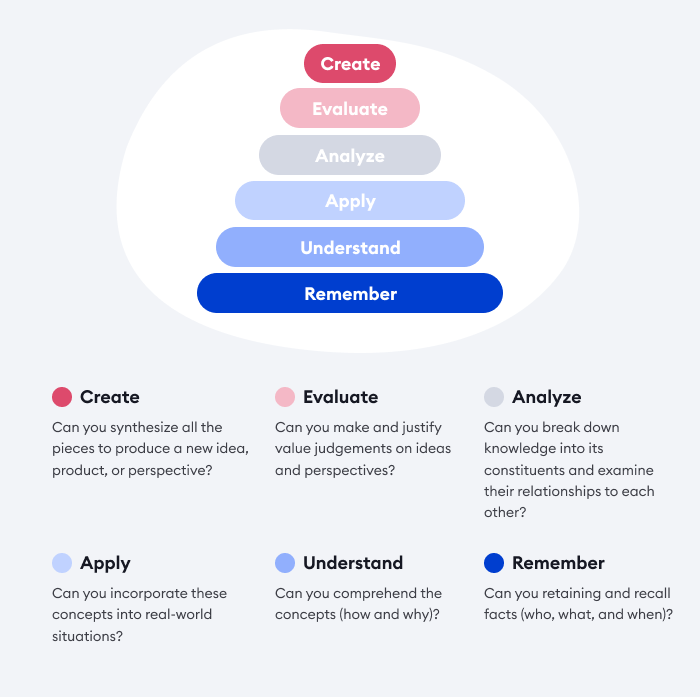
Bloom’s Taxonomy is presented as a hierarchy. This implies that “remembering” and “understanding” new knowledge are lower-order thinking processes than “evaluating” or “creating.” However, what it does not imply or advise is neglecting lower-order processes in favor of higher ones.
- How can you understand something you can’t recall?
- How can you apply a concept without understanding it?
- How can you analyze what you’ve yet to apply successfully?
The idea is that knowledge builds on itself. So trainees must sequentially progress through these “learning steps” for maximum knowledge acquisition (the kind that lasts!).
2. Incorporate Bloom’s action verbs into your learning objectives
As you ascend Bloom’s “learning ladder”, you might have guessed that the verbs you would use to write your learning objectives become more actionable, thus tangible, thus measurable.
So, when designing your learning objectives, ensure that you use verbs that indicate knowledge retention. For example, before diving into the heart of the subject matter, your first lesson(s) or module(s) usually contains general knowledge, which often includes basic facts – the who, whats, and whens. These introductory components won’t usually demand much more than the lower-order thinking process of “remembering.”
Then, building from there, you might have to demonstrate “understanding” by describing or translating these general knowledge concepts in your own words. Note how these verbs are slightly more actionable, and as such, are listed directly above the “understanding” level in the diagram above.
Finally, stay with this process and refer to the verbs in Bloom’s Taxonomy while planning the course – from beginning to the end. When done correctly, the learning objectives you assign to your final lessons/modules will incorporate verbs from the higher-order levels. That’s why, when you take a course, you’re bound to encounter a final exam or project that will demand a lot of time, attention, and comprise a significant portion of your final grade.
The idea is that, if learners have made it to the end, they should have incrementally gained the foundational knowledge and skills required to demonstrate the highest-order of thinking – that is, “creating” something new based on the synthesis of all course components. If they cannot complete the final evaluation to standard, then they lose a substantial chunk of the score and still risk failing.
3. Use the ABCD method to write clear and concise learning objectives
In this section, we’re going to “breathe life” into Bloom’s principles by actually writing out some objectives. This part is quite easy when you adhere to the prescribed ABCD method below.
Audience
Who are you addressing? Who will achieve the desired learning outcome? State this explicitly at the beginning. Because the behavior will be achieved in the future, after the module/lesson/activity is completed, the formula = [Audience + will be able to…]
- Learners will be able to…
- Students will be able to…
- Trainees will be able to…
Behavior
This is where you specify the desired behavior or action you intend your learners to master, by selecting a measurable verb from Bloom’s Taxonomy. For example:
- Learners will be able to describe the steps for administering CPR…
- Students will be able to identify their personal strengths and weaknesses…
- Trainees will be able to reproduce 3D designs and drawings…
Note how you can only choose one of Bloom’s verbs. If your statement entails two or more verbs, it’ll be harder to assess. Can the student achieve the objective or not? It’s a simple matter of yes or no. For example, a student might be able to describe the steps for CPR without being able to perform them.
Condition
Your learning objective “condition” describes the learning context or environment in which the student is expected to achieve the outcome. It ultimately asks, “What resources, materials, and tools are at their disposal that will enable them to achieve the outcome successfully?”
For example:
- Learners will be able to describe the steps for administering CPR, by the end of this module.
- At the end of this activity, students will be able to identify their personal strengths and weaknesses.
- Trainees will be able to reproduce 3D designs and drawings by the end of this lesson.
- At the end of this case study, learners will be able to apply the principles of effective project planning.
As you can see, the condition (C) isn’t necessarily the third element in the formula. It depends on your syntax or writing style. Also note the lack of ellipses (…) at the end of each objective. These learning objectives are complete.
Degree
The degree specifies how well learners should complete the objective, and/or the minimum standards required to do so (e.g., accuracy, quality, and time limits). Note that these aren’t always explicitly stated, especially if you’re writing course-level objectives.
But if you’re writing lower-level objectives (“sub-objectives”) for a specific lesson within a module, or an exercise/activity, then you might write:
- By the end of this module, learners will be able to describe the steps for administering CPR with 100% accuracy.
- By the end of this lesson, students will be able to identify at least 5 personal strengths and weaknesses.
- Trainees will be able to reproduce 3D designs and drawings successfully at the end of this activity.
- At the end of this prep course, learners will be able to apply the principles of English grammar to achieve a minimum score of 75% on the international English proficiency exam.
Note that degree (D) is optional. Very rarely is D explicitly stated at the course level. It’s more relevant at the sub-levels of your course (e.g., specifying your standards for exercises or activities within lessons).
Designing Your Course Using Learning Objectives
In this section, we’re going to briefly walk you through 7 straightforward steps for designing online training from beginning to end.
Let’s get started!
Step 1 – Set learning goals and objectives
To rehash, at the very beginning of course development, the planning and training needs analysis (TNA) stage, you need to assess your audience’s needs – what they know versus what you’d like them to know. This is known as a knowledge gap, which is exactly what your learning outcomes aim to address.
This not only entails defining the overarching purpose of your training course (the learning goals), but the lower level sub-goals (a.k.a. the learning objectives).
The “actionable” nature of each verb, and the hierarchical level they belong to, based on Bloom’s Taxonomy of Educational Objectives, should illuminate the nature of the assessments you develop in step 7 – the development stage.
Though this is the first step, it nonetheless exemplifies the principle of “backward design.” Start with the desired results first and work backward from there, allowing your goals and resultant objectives to inform the rest of your development decisions.
For example, a course on project management might have the following goal and objectives:
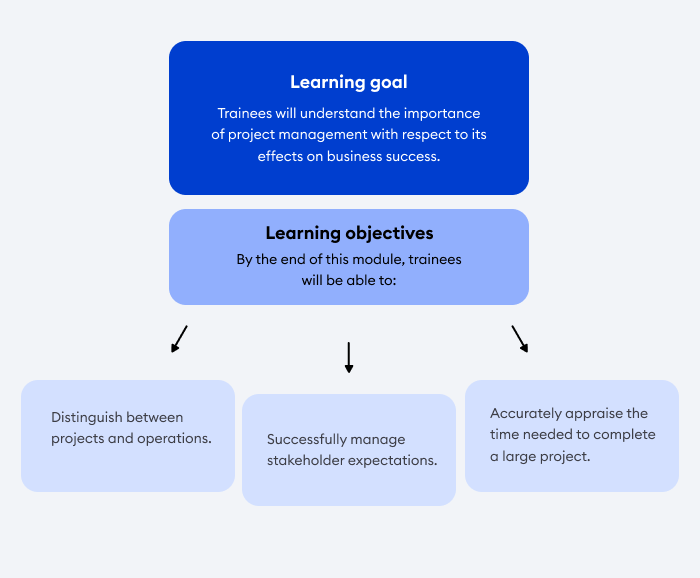
Step 2 – Research and gather materials
Your learning goals and objectives should guide your research and content collection methods. So they’re the first thing you’ll need to determine. As mentioned, define your overarching goal(s) and break them down into learning outcomes. Otherwise, the sky’s the limit when researching, gathering materials, and writing. Your content will be unfocused and your overall training will consequently suffer.
If you’re keen to include certain materials, there’s no harm in adding an “Additional Resources” section at the end of your course.
Step 3 – Develop an outline/blueprint of your course
The next step is to develop an outline or blueprint of your course. Once you’ve compiled an adequate body of research, analyze your notes/materials for broad conceptual divisions (i.e., modules) and break each down into subsections (i.e., lessons/topics).
Your outline is a course roadmap; it maps out the learning path your students need to take. As mentioned, learning occurs through a series of staggered cognitive processes – the lowest order being “remember” and the highest being “create.” It is therefore important to arrange topics and sections such that learners attain knowledge in the same sequence.
Accordingly, the topics they encounter at the beginning should be general knowledge, thereby facilitating memory recall. As learners near the end of the course, topics should become increasingly focused and thus evermore conducive to high-order learning objectives (e.g., “create”).
Step 4 – Analyze your outline for assessment points
Now that your outline topics follow the hierarchical structure of Bloom’s Taxonomy, it’s time to consider your test design. First, analyze your outline for logical assessment points.
Does each lesson address a learning objective? If so, create a short quiz or exercise at the end of each lesson.
Do they need to complete the whole module before achieving a learning outcome? Then you might have an assessment at the end of each module, perhaps with short knowledge checks embedded throughout each lesson.
Ultimately, your desired learning outcomes should constrain your research to your overarching goal, which constrains your outline, which should thus make clear which sections warrant an assessment. Because we ensured your outlined topics progress from general to focused, the relative point you’re at in your roadmap (i.e., beginning/middle/end) should inform which of Bloom’s verbs you use, and your test design.
Let’s revisit one of our learning objectives diagrammed above.
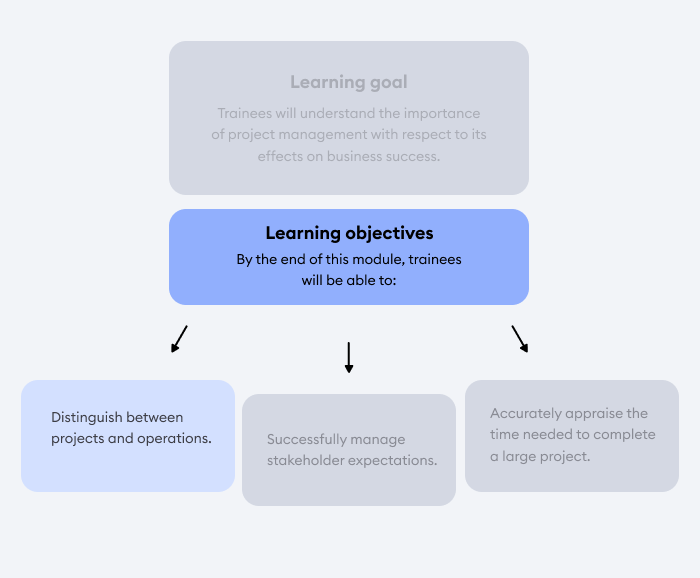
An objective like this is liable to come near the end. As a matter of fact, the verb “appraise” falls under Bloom’s highest cognitive level – “create”. If this is a key learning objective, you might want to incorporate a case study or realistic scenario that allows them to “judge” (yet another “create” verb) based on predetermined conditions.
Intuitively, quizzes and exams might seem like an afterthought – a process that comes after all your content or training’s been developed. But this process is also part of backward design. Each learning objective should be tied to at least one assessment.
Step 5 – Write your content and determine your delivery method
Remember and never forget that while your goals and objectives dictate your content, your content dictates design. So we’re not quite at the “building” part yet. Now it’s time to write everything out according to your outline. Think of your outline as a skeleton that needs some flesh (a.k.a. your content).
Go through your outline, section by section, and refer to your research notes to elaborate on each topic. Only then can you begin writing out your assessments. In the previous step, you determined where they should go in the outline and, based on the actionable verb, your test design.
Coming back to our previous learning outcome, а case study is a great way to test for this outcome. A multiple-choice test isn’t the best way to determine someone’s judgment; the options alone limit one’s ability to “appraise” on his/her own merit. Because multiple-choice quizzes are great for testing memory, you might design more of them near the beginning. But towards the end, you might need students to provide written answers, which is harder to automate.
Accordingly, trainees might need to write out their answers for a human instructor’s examination. To that end, you might consider developing a blended learning program that allows manual grading.
Don’t let the quality of your content suffer by stuffing it into a box. Instead, let the box conform to your content so you don’t limit yourself down the road.
For example, is your content highly conducive to visuals? Then consider creating a video-based course. Is it highly technical or abstract? Consider working with a designer to create custom diagrams/infographics.
Step 6 – Select an appropriate authoring tool
The eLearning industry is inundated with authoring tools for creating an online courses. It becomes nearly possible to choose one of the many options confidently when you’re not even sure of your needs. Fortunately, while content informs your test design and course delivery method, your assessments and delivery method determine the ideal tools to choose. Clarifying your needs helps narrow things down.
When selecting authoring tools and LMSs, consider:
- Your technological proficiency
- The various media formats you’re including
- The degree of interactivity you’ll need
- If your test design is fully automatable
- Whether your training’s blended or fully asynchronous
- Mobile responsiveness
Ideal authoring tools can address all your needs under one roof. iSpring Suite hits every one of these parameters. Not only is it fueled by PowerPoint, whose classic interface is not only familiar but also intuitive. But despite its simplicity, it enables you to create powerful and professional training in virtually every format – slides, video, quizzes, interactions, and role-plays.
This iSpring demo puts it all into action by incorporating image and text slides with engaging interactions and assessments with automatic feedback! Even the most novice training professional could put this together in a jiffy.
Get the iSpring Suite free trial →
Step 7 – Build your course and deliver it to trainees
Now that you’ve drafted your content, use your chosen authoring tool to build your course. Remember, stick to the plan. Ideas are bound to crop up in the development process, but with every deviation from the “script,” revisit your goals and objectives to see if they’re aligned.
Once you’re ready to publish your course, there’s one last consideration: how you’re going to distribute it to trainees. This ultimately boils down to where you plan to host it. Social media platforms like YouTube are helpful for hosting a series of microlearning courses. But you could also host your courses on your company website, a cloud server, or even distribute it via email (based on how you’ve published or packaged it).
But the most common solution is using a cloud-based learning management system (LMS). An LMS allows you to keep your courses organized, manage your learners, and track their progress, activity, and results. Very rarely is training 100% hands off in professional contexts. As such, an LMS system is often the no-brainer choice for ID and L&D experts.
To Sum Up
Learning goals and objectives are often conflated by even the most seasoned experts, but they’re quite different. Learning goals give rise to objectives, which should then dictate the rest of your decisions – all the way from course planning to publishing. Therefore, when drafting your objectives, be structured and intentional about it.
By heeding Bloom’s Taxonomy of Educational Objectives and the ABCD method of formulating learning objectives, you’re bound to get it right the first time.
If you found this article helpful, leave a comment below!

